The
Anatomy of a Bad Story
First published in 1941, the same
year as the
Llana of
Gathol novellas, and two years before Skeleton
Men of Jupiter in 1943, John
Carter and the Giant of Mars is the second last of the Barsoom
series.
Without a doubt, the least liked
and worst regarded of all of the official Barsoom stories is John Carter
and the Giant of Mars. It is clumsy, awkward, the characters
are drawn broadly, the situations cliché, the resolution almost
too pat.

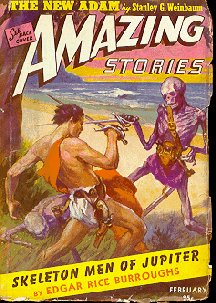
Even its provenance is dubious.
John Carter and the Giant of Mars started off as a children's Big
Little Book. You know the sort? Story on one
page, a picture or drawing on the other, simplified text. It
explains some of the ham-fisted writing of the story.
Burroughs was confined to 15,000
words, and worse, it had to be written so the simplified, child-accessible
text (in which more common terms like ray gun or airplane would crowd canonical
terms like radium pistol or flyer) would suit an illustration on the opposite
page. Burroughs, apparently, had trouble with the rigid format, so
he asked his son, John Coleman
Burroughs, an illustrator to collaborate with him. John
Coleman Burroughs, in addition to helping with the writing and plotting
did the illustrations.
Parts of the story make more sense
given this history. The rather more interesting geography of
Helium's surroundings, for instance, clearly is designed with an illustration
in mind. The picture was almost certainly drawn before the
text arrived.
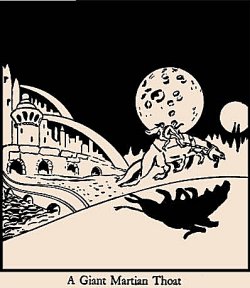
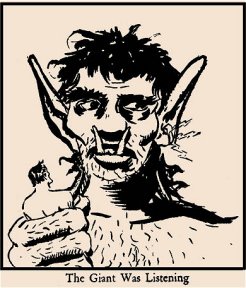
Barsoomian animals had way too many
legs for simple or easy illustrations, so a three-legged creature was both
bizarre, easy to draw (in the same way that four-fingered hands on cartoon
characters are easier to draw than five fingered hands) and simpler to
reproduce. The giant Joog, Pew Mogul, the ‘cage of death’,
the rain of parachutes are all very clearly driven by the demands for simple
yet striking images in a spare small square panel.
The restrictions of the format also
drove the writing. Having to make sure your text is something
that can be rendered into a good picture every 500 words or so forces a
certain rhythm onto the writing. There's a pace, a cadence, which
becomes awkward when you shift it to other formats. The demands to
write for and to pictures also meant that you'd lose a lot of the internal
emotional dynamic. John Carter could no longer share his hopes and
dreams, his inspirations and his concerns. He can only act.
And he has to act something interesting to look at every 500 words.
The audience was going to be children,
not his customary readers. So obviously, Burroughs and/or his
son had to shift from writing for an adult or adolescent audience down
to elementary school children. The dialogue simplifies, the descriptions
and action sequences simplify (but luckily, there will be pictures).
The language itself simplifies.
Esoteric terms like Radium Pistol
or Flyer, well established in the Barsoom stories, were to be introduced
to kids who had no background in those stories, in a format where it would
be hard to explain all the terms all over again. Instead, more
accessible terms like airplane, aircraft, atom gun, ray gun and submachine
gun were introduced.
Later, Ray Palmer of Amazing Stories
asked for a new Mars story, so Burroughs and his son dusted the ‘big little
book’ story off, wrote a new ending and added another five or six thousand
words.
Now remember, this was long before
the days of word processors or computers. The story had been
painstakingly typed out on manual typewriters, and if you wanted to redo
a passage, or even change a word, you might well have to retype the entire
page, or an entire chapter. So it's not as if Burroughs could
fire up the old machine and just ‘adult’ the whole thing up.
Moreover, it had been so carefully
structured for its ‘Big Little Book’ format that a rewrite or polish would
be tricky. Literally, if you started tinkering with it, you
could well wind up getting suckered into spending the time and energy doing
a total rewrite. In fact, the way these things sometimes work,
you could spend more time on the rewrite working out and solving problems,
than you would invest in a new work. So, it was hardly cost
effective under the circumstances.
The simplest thing to do, was to
stick another sheet of paper in, and then just keep tacking on additional
pages to the ending, or sneak in a new chapter here and there. But
then, you've sort of got to hang onto the original style, brain damaged
as it is.
And look at this strategically.
It was a one shot novella. Unlike Llana of Gathol or Escape
on Venus, it wasn't a part of a continuing adventure, it wasn't
going to be assembled into a novel or a book and get republished.
There was no place to go with it. They'd sold it as a big little
book, they'd sold it to Palmer, which was basically free money.
But after that, the story had no place to go, it was fundamentally handicapped
as a dead end.
There is a single line which hints
that at one point, it might have been contemplated as a prologue to the
Skeleton Men of Jupiter. But fundamentally, this was a story
that was painted into a corner. There was no place to take
it, either commercially in terms of publishing and marketing, nor artistically
in terms of characters or adventures.
So, given that it's a dead end with
no place to go, how does Edgar Rice Burroughs, a man who makes his living
as a writer, which means writing strategically, justify throwing in a lot
of extra work to refurbish a story which is transparently weak?
He can't. Basically, he does what he can with it and then moves
on. And that's about it.
Of course, when it gets to Ray Palmer,
well, he's an Editor. He could have edited it to make it more
stylistically consistent with other Barsoom stories, weeded out the anachronistic
words, etc. But he's been begging for the story and Burroughs
is a pretty big name. Does he really want to step on Tarzan’s
toes? All he can really do is hold his nose and let it
go out.
The story has officially always
been credited to Burroughs and published through his company and under
the licenses of his estate. On the other hand, Richard Lupoff, in
Edgar Rice Burroughs, Master of Adventure attributes John Coleman
Burroughs as the primary author.
Personally, I don't have any kind
of window into John Coleman Burroughs writing style, if any. So I
can't really state that the story is more his style of writing, rather
than Edgar Rice Burroughs. And I'm not sure, really, that the
limitations and flaws in the work derive from anything but the restrictions
and limitations that would arise from its publishing history.
A
Whiff of Barsoom
All right. So, once
we've dissed the work, is it really Barsoom? Is this really
John Carter? In all the essentials, I think that it is.
John Carter, slightly dumbed down,
is still the same character we've always known. He's an Earthman,
passionately devoted to Dejah Thoris, unparalleled swordsman, homicidal
maniac, a man who never surrenders, and one who inspires passionate devotion.
His Dejah Thoris is much as we've seen her in other tales.
Tars Tarkas the Thark is sufficiently
stoic and Tharkish, and lord of the feudal Thark tribes. Kantos
Kan is well established as Carter's friend. The cast
of characters is all there, and basically, they come through as who they
are and are established to be.
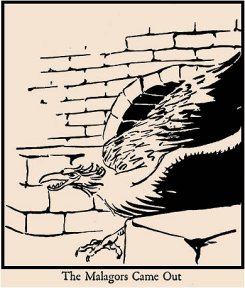
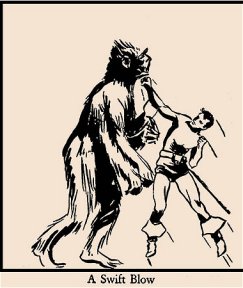
Ras Thavas appears by reference,
something which would have puzzled eight year old readers (Who is that?
The toddler asks). Hormads and Malagors spring direct from
the Synthetic Men of
Mars. The White Apes with transplanted red-man brains
are from the Master
Mind of Mars. The battle of Helium descends to us all
the way from Princess of Mars. The dead city on the sea bottom
is a staple of the entire series.
John Carter and the Giant of
Mars just can't win. When people aren't criticizing it
for showing things we haven't seen, we're condemning it for raiding the
previous books.
And yet, beneath all the handicaps,
the characters ring true, and some of the situations, as when Carter makes
his way among the dried bodies of long dead Korvians, have the feel of
true Barsoom. There are worthwhile nuggets in this story, images
and scenes, bits and pieces, if you're willing to work a little harder
than usual to get them.
Well look, clearly, it is a part
of the Barsoom series, and deserves to be treated as such. The roots
are there and they go deep. What we must do is examine the new branches
and see how compatible they are with the series.
The
Geography of Helium, Revisited
Helium seems rather more interesting
than it has been previously. On the first page, we have this
remarkable passage:
“It was the custom of Dejah
Thoris, Princess of Helium, to ride forth weekly to inspect part of her
grandfather's vast farming and industrial kingdom. Her journey to
the farm lands wound through the lonely Helium Forest where grow the huge
trees that furnish much of the lumber supply to the civilized nations of
Mars. Dawn was just breaking in the eastern Martian sky, and the
jungle was dark and still damp....”
Well, this is interesting.
There's a ‘Helium Forest’? We haven't heard that before.
And quite a forest it is, with huge trees, described as a jungle, and a
major lumber supplier. Also, note the reference to a vast farming
and industrial kingdom, again, sort of an unfamiliar description of Helium.
But there's more, a few pages in,
Pew Mogel leaves a note wherein he says:
“I... have decided to take
over the iron works of Helium. The iron will furnish me with all
the ships I need... If you have not evacuated all your workers from
the iron mines and factories...”
There's a confirming reference to ‘great
iron works,’ suggesting that there Helium possesses either within its twin
cities, or perhaps in some adjacent area, an industrial complex of mines,
smelters and factories... The ‘iron works.’
The geography around Helium continues
to get more interesting in the later chapters. In chapter nine,
John Carter and Dejah Thoris, riding their Malagor come upon the besieging
army. Helium is in a spacious valley. A few breaths
later, the Malagor descends upon a mountain peak overlooking ‘the valley
of Helium.’ It's apparently a very spacious valley. John
Carter reports low foothills between Helium and the mountain peak he is
upon, and refers to mountains in the plural as towering peaks.
Pew Mogel's entire army is camped out in the foothills. Tars
Tarkas forces appear to be in the mountains, and about half of them are
assigned to raid and conduct guerilla activities there.
The Helium fleet, in the next chapter,
retreats over the mountains as it cannot break the siege. Also,
Tars Tarkas green men are camped out in the mountains as well.
Chapter 12 refers to the giant, Jook on the plain between the mountains
and the city. This valley appears to be pretty spacious, since
there's no reference at all to foothills or mountains on the other side
of Helium. This implies that the other side is so far off as to be
strategically useless for either the besiegers or the defenders.
So, there we have it.
Helium sits on a spacious valley, in a plain bordered by foothills and
backed by mountains, the whole area called the Helium Valley.
Somewhere in the area is the Helium forest, and somewhere else presumably,
are the mines, smelters and factories of the Helium Iron Works.
The Helium forest does not appear to be too close to Helium, since there
is no reference to it on the plains or foothills around the city where
Pew Mogel lays his siege. We can also assume that the Helium Iron
Works are also located away from the city, or Pew Mogel would have no need
to make a separate demand.
Hardly the Helium we know.
Or is it?
First, if we turn to the canonical
sources, what we discover is that there's very little information about
Helium's geography. Nice references to the twin cities themselves,
their remarkable towers, their spacious boulevards, the avenue of the ancestors,
the gate of the jeddaks, yadda yadda yadda.
On the other hand, there isn’t much
information as to the actual geography of the area itself.
The best information we have comes about in Princess of Mars, when
John Carter, Dejah Thoris and Sola conspire to escape the Tharks:
"The great waterway which
leads to Helium is but fifty miles to the south," murmured Sola, half to
herself; "a swift thoat might make it in three hours; and then to Helium
it is five hundred miles, most of the way through thinly settled districts.
They would know and they would follow us. We might hide among the great
trees for a time, but the chances are small indeed for escape. They would
follow us to the very gates of Helium, and they would take toll of life
at every step; you do not know them." (Chapter XVI, Princess
of Mars)
Now this is interesting. Note
the reference to ‘great trees’. And not just a few of them,
there must be a forest or jungle of formidable extent if Sola can count
on hiding out in the woods for a while. Ergo, it appears that there
is indeed a ‘Helium Forest’ somewhere in the region of the twin cities.
How about that?
“Taking a great diamond
from her hair she (Dejah Thoris) drew upon the marble floor the first map
of Barsoomian territory I had ever seen. It was crisscrossed in every direction
with long straight lines, sometimes running parallel and sometimes converging
toward some great circle. The lines, she said, were waterways; the circles,
cities; and one far to the northwest of us she pointed out as Helium. There
were other cities closer, but she said she feared to enter many of them,
as they were not all friendly toward Helium.”
Finally, after studying the map carefully
in the moonlight which now flooded the room, I pointed out a waterway far
to the north of us which also seemed to lead to Helium.
"Does not this pierce your
grandfather's territory?" I asked.
"Yes," she answered, "but it is
two hundred miles north of us; it is one of the waterways we crossed on
the trip to Thark." (Chapter XVI, Princess of Mars)
Overall, not terribly helpful.
Hostile cities include Zor and Zodanga, around the time of Carter's first
journey to Mars, around 1860. Neither of which are active enemies
later in the series. In fact, in Giant of Mars, which in chronological
terms probably takes place around 1940, or eighty years later, it looks
like Helium has pacified most of its neighbors. John Carter
in the Giant of Mars tells us:
“Cities for miles around
Helium are now all friendly. They would have warned us of this Pew
Mogel if they had known of him. He has probably taken over one of
the deserted cities in the dead sea bottom east or west of Helium.
It means thousands of miles to search...”
Back to Princess of Mars.
Geographical information continues to be fairly thin. John
Carter describes looking for the cities:
“Helium lies a thousand
miles southwest of Zodanga, and with my compass intact I should have made
the trip, barring accidents, in between four and five hours. As it turned
out, however, morning found me speeding over a vast expanse of dead sea
bottom after nearly six hours of continuous flight at high speed. Presently
a great city showed below me, but it was not Helium, as that alone of all
Barsoomian metropolises consists in two immense circular walled cities
about seventy-five miles apart and would have been easily distinguishable
from the altitude at which I was flying. Believing that I had
come too far to the north and west, I turned back in a southeasterly direction,
passing during the forenoon several other large cities, but none resembling
the description which Kantos Kan had given me of Helium. In addition to
the twin-city formation of Helium, another distinguishing feature is the
two immense towers, one of vivid scarlet rising nearly a mile into the
air from the center of one of the cities, while the other, of bright yellow
and of the same height, marks her sister. (Chapter XXIII, Princess
of Mars)”
So, roughly southwest of Zodanga, a
thousand miles, two circular walled cities 75 miles apart with two immense
towers. Got it. Notice that there's no description of
the surrounding countryside. In Chessmen of Mars, one
of the Towers falls:
“And in another instant
was the Vanator forgotten as the lofty, scarlet tower that had marked Lesser
Helium for ages crashed to ground, carrying death and demolition upon the
city beneath. Panic reigned. A fire broke out in the ruins. The city's
every force seemed crippled, and it was then that The Warlord ordered the
men that were about to set forth in search of Tara of Helium to devote
their energies to the salvation of the city, for he too had witnessed the
start of the Vanator and realized the futility of wasting men who were
needed sorely if Lesser Helium was to be saved from utter destruction.
(Chapter II, Chessmen of Mars)
So, Lesser Helium isn't doing too well.
Later on, in Llana of Gathol, Carter offers us this bit of geographical
information:
“Upon the occasion of which
I am about to tell you I flew northwest from Helium, which lies 30 degrees
south of the Equator which I crossed about sixteen hundred miles east of
Exum, the Barsoomian Greenwich. North and west of me lay a vast, almost
unexplored region; and there I thought to find the absolute solitude for
which I craved. I had set my directional compass upon Horz, the long deserted
city of ancient Barsoomian culture, and loafed along at seventy-five miles
an hour at an altitude of five hundred to a thousand feet. I had seen some
green men northeast of Torquas and had been forced up to escape their fire,
which I did not return as I was not seeking adventure; and I had crossed
two thin ribbons of red Martian farm land bordering canals that bring the
precious waters from the annually melting ice caps at the poles. Beyond
these I saw no signs of human life in all the five thousand miles that
lie between Lesser Helium and Horz. (Chapter 1, Llana of Gathol)”
And that's about it. Roughly
30 degrees latitude, somewhere abouts. Given that the reference
point, Exum, is never confirmed, we can't even guess at the longitude.
Recourse to John Flint Roy's Guide
to Barsoom (don't leave home without it) gives us this (abridged) information:
“Its boundaries extend
from the southern ice fields, where water is obtained for its canals, to
and beyond the equator and from the borders of Torquas in the west to an
undefined frontier far to the east.... Within the borders of
the Empire are several dry seabeds, ranges of modest mountains, miles of
rolling hills and here and there, valleys whose soil still holds enough
moisture to support small forests, the commercial value of which cannot
be overestimated. Mining is fairly extensive.... The
two cities lie on a broad plain....”
This is broadly consistent with John
Carter and the Giant of Mars, significant since Roy has deliberately
excluded that story from his ‘canon’ survey. And it does hint
at something which is never alluded to, but has to naturally follow.
Helium is a major industrial and
technological power. What the hell do they make? Tupperware?
Hardly. We're clearly shown that Helium has the largest and
most advanced fleet of warships, its cities are architectural wonders.
Well, they're not buying their warships, they're building them.
Which suggests that Helium has a substantial industrial base, an industrial
complex for mining, smelting, refining and various kinds of manufacture.
In essence, if Helium doesn't have a great Iron Works in the rest of the
series, then obviously, it needs one.
There is contradictory information
in the series. At one point, Carter goes out of his way to diss Barsoom's
mountains, most of which are puny by Earth standards. However,
through the course of the book, he seems to acknowledge both the Otz and
Torquas mountains as significant ranges, and the Artolian Hills, being
tall enough to be snow capped, seem to be in a class of their own.
But overall, we aren't given any
information which contradicts the description of John Carter's Helium (one
of them anyway) being in a spacious valley, on a large plain bordered by
foothills and then mountains. In Giant of Mars, we get
more detail which seems remarkable to us, mainly because previously, we
had almost no detail
Finally, in my “Matching
Mars” articles, I attempt to locate Barsoom on Mars, using a topographic
map as my guide. My candidate is at the eastern edges of the
Hellas Basin about latitude 30. It's a rocky area surrounded by low
mountain ranges, hills, and broad valleys. In short, the Helium of
Giant
of Mars matches or adds to the geographical knowledge that we have
or can reasonably infer. It isn't necessarily contrary.
Korvas:
Dead City, Dead End
Pew Mogel's headquarters is Korvas.
Described as "A deserted city at the banks of the dead sea at Korvas."
Latitude and Longitude are given, but unfortunately, not given to us.
The location is mostly framed for
us in negative terms. It isn't anywhere close to Helium, and
somewhere to the east or west:
“Cities for miles around
Helium are now all friendly. They would have warned us of this Pew
Mogel if they had known of him. He has probably taken over one of
the deserted cities in the dead sea bottom east or west of Helium.
It means thousands of miles to search...”
Meanwhile, John Carter winds up travelling
a vast distance. He notes that he is over 500 miles out from
Helium in his search. He sets his aircraft on autopilot and
then has a snooze. The next morning, he's given the location of Korvas,
but, maddeningly enough, we are not.
There is only a bare bit of directional
information granted to us. As John Carter and Dejah Thoris
escape Korvas and head for the city of Helium, they stop at the city of
Thark to recruit Tars Tarkas’ green warriors. This implies
that Thark may be somewhere roughly between Helium and Korvas.
This means that Korvas is somewhere east of Helium.
Pew
Mogel, His Life and Wonderful Works
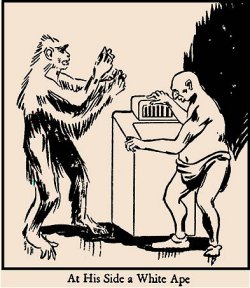 Pew
Mogul is a bizarre creature. A hideous form, he is a microcephalic
with a tiny bullet head, a hulking crooked torso, one arm longer than the
other, one foot larger than the other, yellow teeth, a thick tongue, claw
like hands and not a hair anywhere on his body. One of his
eyes has a disconcerting habit of popping out. Severing his
head from his body doesn't halt his body from attacking or his head from
screaming. He claims, with some justification, that he cannot
die.
Pew
Mogul is a bizarre creature. A hideous form, he is a microcephalic
with a tiny bullet head, a hulking crooked torso, one arm longer than the
other, one foot larger than the other, yellow teeth, a thick tongue, claw
like hands and not a hair anywhere on his body. One of his
eyes has a disconcerting habit of popping out. Severing his
head from his body doesn't halt his body from attacking or his head from
screaming. He claims, with some justification, that he cannot
die.
Well, John Carter has seen this
before. He's a Hormad, one of Ras Thavas’ synthetic men.
But Pew Mogul is arguably not just a Hormad, but the first Hormad.
This is based on a single line of dialogue:
“I am Ras Thavas’ Artificial
Man. I never die. I never die!!”
He's not ‘an’ artificial men, rather
he considers himself ‘the’ Artificial Man. Now perhaps this
is simply Hormad puffery, he rolled off the assembly line and called himself
by the definite article. But then, why wouldn't he say ‘greatest
of the artificial men’ or some such phrase, and in fact, he does claim
to be Ras Thavas’ greatest creation.
In that, he's probably not far off.
Pew Mogel's accomplishments, including duplicating Ras Thavas brain transplants
on a massive scale, recreating a comparable laboratory, constructing Joog,
breeding a gigantic flock of modified Malagors, secretly assembling and
equipping a huge army, and inserting spies and assassins into the heart
of Helium, speaks to a degree of genius which may well be in the same elevated
leagues as Ras Thavas and Phor Tak themselves. In addition, the deformed
monster does not lack for either courage or leadership. It
took remarkable resolve to flee Morbus for the wild yonder, and remarkable
persuasion to bring so many of his companions with him.
But in his moment of anguish, the
way he says it admits to no other artificial men. In short, Pew Mogul
is drawing a distinction. It's a thin argument, but one worth
pursuing.
There are a couple of pieces of
evidence which suggests that Pew Mogul may well have been the original
artificial man, or certainly a very early experiment.
One of these is that Pew Mogul possesses
a skill literally unique on Mars, an ability to do neurosurgery to the
level of successfully transplanting brains from one creature to another.
Of all the beings on Mars, only Ras Thavas himself and Ulysses Paxton possess
this skill.
So why does Mogul have it?
It's possible that Ras Thavas decided to teach it to the Hormad after Ulysses
Paxton shows up. But why bother? The whole point of teaching
it to Paxton in the first place is not to take the pressure of work off,
but so that Paxton can operate on Ras Thavas. And here's the
thing, Ras Thavas has been looking for a trustworthy disciple for a long
time. There seems no good reason he'd bother to educate and train
the Hormad in his most prized skill after he has obtained his own brain
transplant.
What seems more likely is that Ras
Thavas, dissatisfied with the Red Men he worked with, and lacking trust
in them, decided to create his own artificial man in order to do the brain
transplant that he needed. Pew Mogel was thus, effectively
a tool that Ras Thavas intended to use, and perhaps discard.
Mogel responded by running away,
and building his own laboratory. And this is another clue to
suggest that Pew Mogel goes way back. He's been out in Korvas
for a very, very long time. He didn't move out there last week,
or even any time within the last few years.
The record shows that he's had time
to create his giant, Joog. Joog the giant, while a singular
being, is not implausible in Barsoomian terms. Sure,
he's a 130 foot giant, manufactured by hybridized tissues and rendered
invulnerable. But the Synthetic Men of Mars produced
a similar monstrosity, the ameboid growth in vat 13 that devoured Morbus,
and threatened all of Barsoom Joog is merely more coherent,
and perhaps because of the introduction of hybrid tissues, perhaps more
resilient. Joog himself, while colossal, may actually be built
to the scale of Zitidars, who seem to be dinosaur sized. So he may
not even be beyond the outer norms of the planet.
Pew Mogel's had time to transplant
the brains of thousands of criminal red men into white apes.
To breed a fleet of Malagors (and apparently to imbue them with the unnatural
strength and endurance to meet mechanical flyers on nearly equal terms).
He has had the time to build and equip both a lab and an army, and speaking
of that army, he's had to devise and adapt weapons to the sizes of great
white apes, as well as tinker with his malagors and malagor mountings.
He's had to train them, prepare them, and organize battle plans.
This is not something that can be done quickly or easily.
He's been there so long, working
covertly, that ‘Barsoomian rats’ have literally had time to build a culture,
to erect buildings out of the bones of his discards.
In short, Pew Mogel has been beavering
away in Korvas for centuries at least, perhaps even close to a millennia.
This puts him well before the date of Synthetic Men of Mars, and
in fact, well before John Carter's arrival on Barsoom.
Pew Mogel may reach back deep into
Ras Thavas history, to his original labs at the site Ulysses Paxton materializes
(although Mogel notes that he made his escape from Morbus, with a hundred
other artificial men and a flock of Malagors). How far back
does Mogel go? He might well date back to Thavas’ estrangement
from his native city, Toonol. He might date back to the end of Thavas’
first millennia, when age was first creeping up on the genius.
He might have a hand in other incidents
heretofore unexplained. In this, I'm thinking of the
mysterious attack on the atmosphere plant at the end of the Princess
of Mars. Who else might wish for the death of the entire world,
but for an immortal synthetic man who believes that he will survive all
else?
And then, finally, there is this
remarkable line in his ransom note:
“I... have decided to take
over the iron works of Helium. The iron will furnish me with all
the ships I need to protect Helium and the other cities of Barsoom from
invasion.”
Little did we know, there actually
is an invasion of Barsoom in the offing. The Skeleton Men of Jupiter,
the invaders from Eurobus, were even then preparing their assault.
Did Pew Mogel know? If so how? We can only speculate.
Perhaps Pew Mogel's biography might
well solve a few riddles.
Strange
Fauna
In the Giant of Mars, we've
got some critters, some of which we've seen before, some of which we haven't.
One of them, unfortunately, really seems to stick in people's craw.
There are, for instance, Thoats,
well established as eight legged horse-like creatures. There
are Great White Apes, which initially seem smarter than average.
It turns out that they have transplanted human or hormad brains.
And then there are Malagors, great flying birds large enough to carry a
green martian, or a couple of human sized persons.
All of the Malagors have apparently
been bred from a small flock that Pew Mogel took with him from the Toonolian
Marshes and the island of Morbus. Although it is never
referred to directly, these Malagors don't seem precisely like the nearly
extinct bird of the Marshes. For one thing, their endurance
is phenomenal, they can fly thousands of miles from Korvus to Helium, nonstop,
or with very few stops. They can carry Great White apes and
heavy loads of equipment. Indeed, a flock of them can carry Joog.
Meanwhile, in aerial combat, they are able to meet Helium's mechanical
aircraft, the speeds and capacities of which are very well established,
on very nearly even terms. In short, these Malagors have likely
been altered by Pew Mogel, modified, perhaps, by the same processes that
give the hormad its resilience.
But past that, there are creatures
that we have not seen before.... Arboks, Reptiles and most
unusually, a giant three legged rat that is definitely not an ulsio.
The Arbok is apparently, a reptilian
forest creature. A sort of poisonous tree dwelling lizard or
snake which hunts by ambush and is large enough to pose a handful to John
Carter. Dejah Thoris describes these creatures as monsters,
and assures Carter that her father and grandfather have had the species
hunted out in the Helium forest. Not quite correct. And
that's all the description we have.
Well, we haven't seen the Arbok
before. But perhaps there was no reason that we should have.
There are not many forests around, and for the most part, Carter doesn't
spend a lot of time in forests and jungles. There's nothing about
this creature that would exclude it from Barsoom.
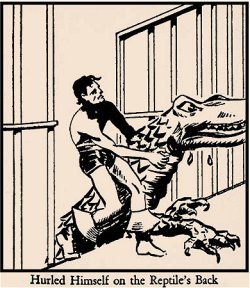 Later,
in Pew Mogel's lair John Carter and Dejah Thoris are menaced by reptiles.
We don't have much of a description of these reptiles at all.
They are semi-aquatic creatures, living in the water pit in which Mogel
has situated his fiendish death trap. Oddly enough for reptiles,
they are apparently warm blooded, since at one point, our heroes feel their
hot breath. They have reptilian jaws, but apparently flexible
forelegs with gripping paws since they reach through the bars of the cage.
Later,
in Pew Mogel's lair John Carter and Dejah Thoris are menaced by reptiles.
We don't have much of a description of these reptiles at all.
They are semi-aquatic creatures, living in the water pit in which Mogel
has situated his fiendish death trap. Oddly enough for reptiles,
they are apparently warm blooded, since at one point, our heroes feel their
hot breath. They have reptilian jaws, but apparently flexible
forelegs with gripping paws since they reach through the bars of the cage.
Reptiles are found on Barsoom, particularly
in the Toonolian Marshes. But there is a giant lizard encountered
at Ghasta. It is unusual for reptiles, particularly large dangerous
ones to be found in a dried out, dead city.
The most likely explanation is that
these reptilian creatures may actually be failed experiments of Pew Mogel,
perhaps transplanted Toonolian reptiles, or grown from reptile tissue that
was brought by Pew Mogel and his men during his escape. It's
worth noting that on Earth, certain reptiles and amphibians have regenerative
qualities, a quality that the hormads share in extreme fashion. It's
likely that Thavas, when imbuing his hormads, incorporated reptilian tissue.
Hence, reptiles or reptilian tissue might form an important component in
Pew Mogel's stores.
 The
big howler, of course, is a Martian Rat which is definitely not the Ulsio.
Carter has encountered the Ulsio several times, and its almost always been
a bad experience. The Ulsio is a many legged (number undefined) omnivorous
scavenger about the size of an Airedale terrier which digs and inhabits
tunnels beneath cities living and dead. It's most notable feature
is a horny face covering, a sort of bill or beak, which resembles bone
and gives the creature the appearance of a rotting face partially exposed
to the bone.
The
big howler, of course, is a Martian Rat which is definitely not the Ulsio.
Carter has encountered the Ulsio several times, and its almost always been
a bad experience. The Ulsio is a many legged (number undefined) omnivorous
scavenger about the size of an Airedale terrier which digs and inhabits
tunnels beneath cities living and dead. It's most notable feature
is a horny face covering, a sort of bill or beak, which resembles bone
and gives the creature the appearance of a rotting face partially exposed
to the bone.
John Carter several times calls
the Ulsio a Martian Rat in previous books. We assume he's referring
to the Ulsio's tunnel crawling habits, its infestations of cities and its
omnivorous scavenging nature. But ‘Rat’ is an Earth word, and the
creature's true name is Ulsio.
The creatures that John Carter encounters,
whatever else they are, are not Ulsios. These creatures
are three legged rather than many legged. In fact, that's part
of their description. They are not just Martian Rats, but ‘Three
legged Martian Rats’, in much the same way that a a bald eagle,
crested nuthatch, white tailed deer or gray wolf are named after their
distinctive physical features.
There is no mention of the Ulsio's
horrific ‘rotting face’ appearance, with these creatures. On the
other hand, these creatures, whatever they are, have long scaly rat-like
tails, which they can use like whips or clubs. Other features
mentioned are yellow teeth and gleaming green or pink eyes and whiskers.
They have two hind legs and a single foreleg, which appears to double as
a hand when they sit or walk upright. They have external ears.
They seem somewhat larger than Ulsios as well.
Where they truly differ from Ulsios
is in intelligence and behaviour. These creatures are, at the
very least, semi-sentient. When they capture John Carter,
they do not immediately devour him. Instead, they drag him to their
‘community.’ John Carter observes them constructing huts of
bone and garbage. They have a dominant male, a king, who engages
in ritualistic behaviour, constructing a circle of skulls and then throwing
them one at a time at Carter. Meanwhile, the other ‘three legged
rats’ form two circles of dancers around the pair.
Now, we don't and cannot know what
this means. But the signs are unmistakable that we are witnessing
intelligent ritual social behaviour. Aspects of this behaviour
are duplicated in animals. Beavers build lodges, and many other animals,
including bowery birds, build elaborate nests. Honeybees dance.
Excited dogs will course in circles. But the combination of features
here suggests, at the very least some sort of proto-sentient colony or
hive social structure and at least monkey or ape-like levels of intelligence.
Ulsios display neither these signs
of intelligence or social behaviour. The Ulsio's that
we see are solitary, if fierce, burrowers. There's no sign
of Ulsios congregating in social groups, engaged in anything more constructive
than building more tunnels, or exhibiting any kind of ritual behaviour.
So, perhaps this is just a situation
where John Carter ascribes ‘rat’ qualities to two different creatures,
and uses the name.
Morphologically, the ‘three legged
rat’ is a unique creature. Burroughs Barsoom features a variety
of life forms of 16, 10, 8, 6 and 4 legs. Even Birds have four limbs,
two feet and two wings. An odd numbered limb creature is distinctive.
But perhaps not out of the question.
We know that on Earth, some animals divert from bilateral symmetry.
Crabs, for instance have two different kinds of pincers on their front,
usually a gripping claw and a cutting claw. We also know that
on Earth, some animals, such as snakes, sea mammals and certain flightless
birds lose their limbs. So, perhaps what we are seeing here
is a reductive process a four limbed animal reducing down to three?
Why or how is a mystery.
Unfortunately, the description of
the creatures is too brief and too vague to allow us to perform a more
detailed analysis. Perhaps some of the illustrations from John Coleman
Burroughs would be of assistance. But these images are not available,
so far as I know.
In some ways, the ‘three legged
rats’ are reminiscent of George Pal's Martian invaders from ‘War of the
Worlds,’ or perhaps Larry Niven's Moties from the Mote in God's Eye.
But any such resemblance or suggestion is completely coincidental.
This is a weak and little known work of Burroughs, and the other affinities
are decades later. In any event, Barsoom has a strange enough
assortment of flora and fauna, including plant men and kaldanes that a
three legged creature is bizarre, but perhaps not completely out of place.
Nor does Burroughs shy away from mentioning new or additional creatures
from one book to the next.
Whatever these creatures are though,
clearly, they are something John Carter has seen before. He recognizes
them enough to describe them. He betrays little surprise.
Like the Arbok, and perhaps unlike the pit reptiles, they are probably
a fairly widespread form of life on Barsoom.
So, why call them ‘Martian Rats’
and create all the confusion with Ulsios? Once again, we must
note that the term ‘rat’ is an earthly terrestrial term. It
is being applied to a Barsoomian creature based on some trick of resemblance
of appearance, habitat or behaviour.
Sure to cause confusion?
Perhaps. This may be why Carter is careful to mention it's the ‘three
legged’ variety.
But if the creature is relatively
common, or at least not unknown on Barsoom, why haven't we seen or heard
of it before. The most nakedly honest explanation is that they
haven't bothered John Carter before this. Remember, Carter
is a fighting man, not a naturalist. He's not all that concerned
with laying out a detailed taxonomy of Barsoomian life. He
never bothers to tell us, for example, how many legs a Zitidar has, or
what exactly it looks like.
Mostly, when John Carter (or Burroughs
other heroes) are describing animals, they are most concerned with those
animals that are dangerous or helpful to them, and even then, their descriptions
of dangerous ones are sometimes confined to the dangerous parts of them.
So, if you're John Carter, skulking
around a deserted city, hiding from Green Men, watching out for White Apes,
fighting Banths, looking after Thoats and Calots, and keeping an eye out
for Ulsio.... Perhaps, in a parade like that, a relatively
harmless three legged rat is just not going to make a big impression.
What makes these rats particularly
distinctive is the huge size of their colony. When hunting
rats, John Carter goes through the trouble of going to the Korvas colony.
One would expect that if there were large enough colonies closer by, he
would have gone there. Thus, if we assume that the ‘Three legged
rat’ is not a rare species, other colonies must be tiny in comparison.
Carter goes back to Korvas because that's where the numbers are.
And of course, the other thing that
makes this colony distinctive, is that they've been eating human flesh
for quite some time, and may have acquired the taste. Hardly
comforting, considering the size of the colony.
This may be one of the rare occasions when Carter would consider such creatures
dangerous and threatening.
Arguably, it's a thin explanation.
But hey, we work with what we've got.
Other
Anomalies
Terminology differs substantially
from other Barsoom stories. For instance, radium pistols and
rifles are referred to as atomic guns and ray guns. It appears
that these additional terms are synonyms, since the radium pistol or radium
rifle is still used, and the weapons appear to function in the same way.
A reference to ‘submachine gun’ while an incongruously Earthly term is
still likely a reference to a variety of radium weapon.
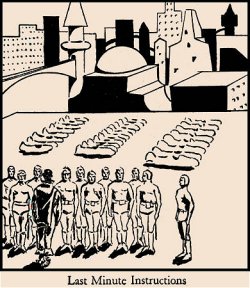 The
Barsoomian flyers are seldom referred to by that name, the term Aircraft
and Airplane are used instead. At least some of the flyers
have closed cabins or cargo spaces, but again not unheard of.
The
Barsoomian flyers are seldom referred to by that name, the term Aircraft
and Airplane are used instead. At least some of the flyers
have closed cabins or cargo spaces, but again not unheard of.
The language is a tricky thing.
Viewed objectively, a rose is a rose, whatever you call it. We know
that atom gun or ray gun or airplane are just other words, equally suitable,
for the things we know; radium pistols and flyers. It still
rings false in our ears. But what the heck, deal with it. Even
Burroughs best hits false notes.
Parachutes are seen and used, as
is radio equipment. Neither of these things seem to be commonly
found on Barsoom, at least, we haven't seen many previous references.
But on the other hand, there's no reason why they couldn't or shouldn't
be on Barsoom.
One notable matter is that the story
is told, not from the first person singular viewpoint of John Carter, but
from a third person narrative. Thus, for a change, John Carter
is not speaking to the audience directly. He is the principle character,
and the narration follows closely. Rather, his words are being
attenuated. The change of terms and slang cheapens the work, but
doesn't invalidate it.
Some of the anomalies are not true
anomalies, but merely marks of the passage of time and circumstance.
In
Princess of Mars, Dejah Thoris describes a Helium surrounded
by unfriendly states. By the time of Giant of Mars,
most of Helium's rivals have either been conquered or pacified.
At one point, a distraught Dejah
Thoris tells Carter “Thank Issus you are alive.” Issus is the
discredited false goddess of the Iss cult, which was brought down in the
Gods of Mars. But old habits die hard, and one can imagine
her reverting to empty colloquialisms in times of stress.
Princess of Mars records
the numbers of the Thark nation as around 40,000. But in Giant
of Mars, Tars Tarkas leads 100,000 Thark in defense of Helium.
An inconsistency of numbers? Or perhaps a natural expansion?
In Princess of Mars prior to the sack of Zodanga, Tars Tarkas gives
this speech to his Tharks.
"John Carter suggests that
we rescue her and return her to Helium. The loot of Zodanga would be magnificent,
and I have often thought that had we an alliance with the people of Helium
we could obtain sufficient assurance of sustenance to permit us to increase
the size and frequency of our hatchings, and thus become unquestionably
supreme among the green men of all Barsoom. What say you?"
(Chapter XXIV, Princess of Mars)
Well, the Thark have been allied with
Helium for decades now, it's been as much as 70 years since Tars Tarkas
met John Carter. They've grown rich and powerful through that
alliance. Their numbers have increased through hatchlings and perhaps
by incorporating Warhoon tribesmen into the Thark nation. So, by
this time, they are unquestionably supreme among the green men of all Barsoom.
At
the End of the Day
John Carter and the Giant of
Mars will always be considered the red headed stepchild of the Barsoom
canon. Without a doubt, it is the most poorly written and awkwardly
constructed. The fine etchings of Burroughs characters and situations
are reduced to crude scrawls. And that is going to count, no
matter what. Of the nine novels and six novellas, this is the
least of them.
But, like it or not, it seems that
it was at least co-written by Burroughs, and is officially a part of the
series as much as Skeleton Men of Jupiter.
The temptation is to ignore it.
But I would argue that this isn't the way to go. As inconsistent
as it seems, there is arguably nothing in John Carter and the Giant
of Mars that definitely contradicts the other Barsoom tales.
The tale of the Giant can be fit comfortably into the Barsoom canon.
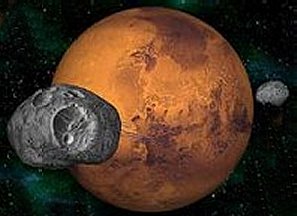
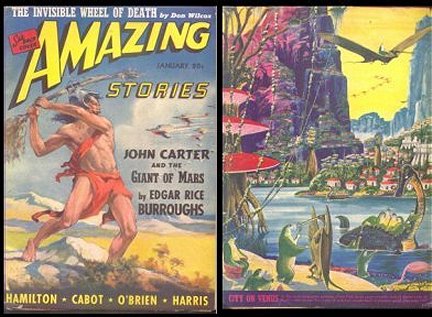
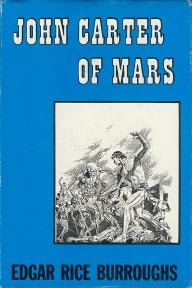
![]()

![]()
![]()

![]()